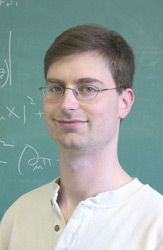Erlich's paper outlines the modeling of quantum chromodynamics
 Traditional physics has long identified
four forces. Most people are familiar with gravity and
electromagnetism. Less well-known, except among physicists, are nuclear
interactions known as the strong force and the weak force, which is
seen in particle decay.
Traditional physics has long identified
four forces. Most people are familiar with gravity and
electromagnetism. Less well-known, except among physicists, are nuclear
interactions known as the strong force and the weak force, which is
seen in particle decay.
This is a story about the strong force but ends up involving all four fundamental forces. The strong force is what binds protons and neutrons together in the nuclei of atoms. A theory called quantum chromodynamics (QCD) describes how the strong force operates.
Joshua Erlich, assistant professor of physics at William and Mary, is one of the authors of an article, "QCD and a Holographic Model of Hadrons," which outlines a proposal for modeling certain aspects of quantum chromodynamics in five dimensions. The paper, recently published in the journal Physical Review Letters, bolsters physicist Juan Maldacena's connection of QCD with string theory. String theory, in effect, holds that the four forces-gravity, electromagnetism and the strong and weak interactions-are manifestations of the same thing.
"What Maldacena showed was that if you have a theory which looks in
many ways like quantum chromodynamics, but not quite, there's another
way of looking at it which is exactly equivalent," Erlich said. This
dualistic way of looking at things is called holography.
"It's the
idea that a surface with a smaller number of dimensions might contain
all of the information to describe another kind of world which has more
dimensions in it," he explained. String theory, Erlich said, works in
10 dimensions: nine spatial dimensions plus time, although for his work
only four spatial dimensions plus time are important. Our day-to-day
existence, of course, takes place in a world of three spatial
dimensions. Add time, and ours is a four-dimensional world.
In their paper, Erlich and his co-authors outline a way to construct a holographic twin of quantum chromodynamics. The proposed holographic twin is a five-dimensional description of the same strong-force interactions illustrated by quantum chromodynamics in our everyday four-dimensional world. The five-dimensional twin is, essentially, another window through which to view the strong interactions, although holographic duality also has implications for string theory.
The strong and weak interactions and electromagnetism all are governed by the same set of principles under what physicists know as the standard model-but gravity does not fit.
"Gravity is the strangest of all the forces, meaning we understand it the least," Erlich said. "The only quantum theory which seems to work that includes gravity together with other interactions is string theory." He said that the higher dimensional gravity of string theory makes itself known through holographic duality in the form of particles that exist in its four-dimensional twin.
"The holograph is a completely different world which has gravity in it, and it has more dimensions than the three spatial dimensions in our world," he said, "and they're exactly equivalent."
"It's just not obvious that these two worlds are the same," he continued. "Anything you can calculate in one, you can calculate in another. There's a dictionary for how to calculate things between one world and things in another."
This dictionary, or map, between the two worlds has allowed physicists to make a number of discoveries regarding the nature of the strong force through a property known as chiral symmetry, Erlich said. "This symmetry maps onto a set of interactions in this extra-dimensional world which is dual to the strong interactions, so now we input the physics and we ask what comes out."
What has come out, at least so far, is that predictions of the mass of certain particles made in the five-dimensional world are accurate to real-world measurements within 10 percent. "If you tell a string theorist that you predicted something in the real world to 10 percent accuracy, he'll get very excited because it's very difficult to make physical predictions from string theory," he said.
Erlich explained that tests of the accuracy of the model make it a good candidate for work such as calculating masses of mesons and predicting the interaction between particles. "The physics of this is difficult to study from the perspective of quantum chromodynamics but easy to study from the perspective of this higher dimension," he said. "It's really a great tool. It would be even greater if we could understand why it works so well. If we trust it and then just follow our nose, it makes really nice predictions."
 Skip to main content
Skip to main content
